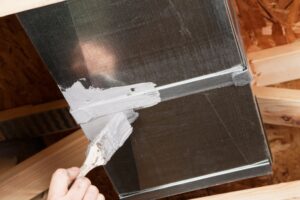If your home has ductwork that carries your heated and conditioned air throughout your house to evenly distribute it, chances are, you don’t think about those ducts very much. After all, they’re mostly behind walls or in your attic. Out of sight, out of mind! But problems can occur in ductwork that might be having a big impact on your home comfort and your energy bills. How can ducts be damaged? How can you tell if there are leaks? What can be done to repair them? We’ll give you all the info.
How Duct Leaks Occur
Much of the time, when ducts are cracked or torn, it’s simply a matter of the materials and joints deteriorating with age. However, even very new ducts can be damaged. Accidents during home improvement projects and holes caused by rodents are common culprits. Even improper installation can leave you with brand-new ductwork that doesn’t hold the air in very well.
Effects of Duct Leaks
According to the Department of Energy, heated or conditioned air lost through duct leaks can add hundreds of dollars a year to your heating and cooling bills! But there’s more than just inefficiency to be concerned with. Air from outside the ducts can be sucked in, decreasing your comfort and potentially adding dust, rodent mess, insulation fibers and more to the air that you’re breathing. This added dust can be hard for your heating and cooling systems to cope with. And beyond just the dust, your heater and air conditioner are designed to work with a specific air pressure, and when leaks throw that off, problems can develop.
Diagnosing Duct Leaks
If you spot any of these signs that there’s a leak somewhere in your ductwork, you need duct repair in Celco.
- Noises: Whistling or humming sounds can be caused by air being sucked or blown through craks in the ductwork.
- Cold Spots: During AC season, if conditioned air is leaking into your walls or ceiling, you may find spots that are cold to the touch. In the winter, these spots would be warm.
- Air Flow Problems: If the air coming from any or all of your vents is a listless trickle instead of a steady blast, the air you should be getting may have been lost to leaks in the ductwork.
- Air Temperature Problems: If you’re getting lukewarm air from your vents instead of nice, icy conditioned air (or the reverse in the winter), it might be because air from outside the ducts is mingling with your conditioned air and affecting the temperature.
- High Energy Costs: If your duct problems have been going on for a long time, you probably won’t notice a sudden spike in your utility bills, but if that does happen, or if you suspect they’re too high in general, it could be because of your ducts.
- Dust: If you notice a lot of dust on your vents, or clouds of dust puffing out when the heat or AC comes on, it might have been pulled in through damaged ducts from your attic or between your walls.
How Duct Leaks Are Repaired
There are three approaches to leaking ducts, based on the severity of the problem. First, if leaks are localized, the damaged areas can be sealed. Don’t try to use duct tape—despite the name, it cracks and dries out from the temperature fluctuations. A strong, flexible sealant is required. Second, if leaks are extensive but only in one portion of your ductwork, that segment can be replaced. And third, if the damage is widespread, likely with very old ducts simply falling apart from age, the entire system of ducts can be replaced.
Want to find out your options and stop paying those hundreds of extra dollars per year?





